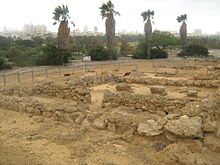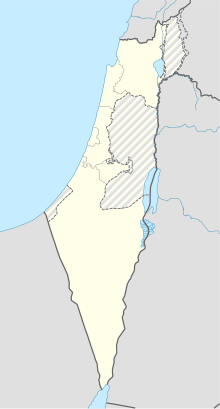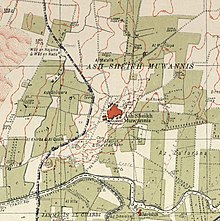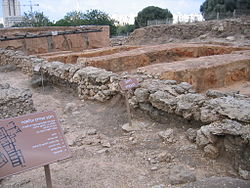 Tel Qasile, 2009 Tel Qasile, 2009 | |
 | |
| Location | Israel |
|---|---|
| Coordinates | 32°6′5.76″N 34°47′23.2″E / 32.1016000°N 34.789778°E / 32.1016000; 34.789778 |
Tell Qasile is an archaeological site near the Yarkon River in Tel Aviv, Israel. Over 3,000 years old, the site contains the remains of a port city founded by the Philistines in the 12th century BC.
Prior to 1948, it was on the village lands of Al-Shaykh Muwannis, which was depopulated in the 1948 war. While the war was still ongoing, in late 1948, the site was given the first archaeological permit by the newly declared of state of Israel. Today it is located on the grounds of the Eretz Israel Museum, which was built in 1953.
Prior to these first excavations, two important ostraca were discovered at the site in 1945-96, by Jacob Kaplan and Robert Hoff.
Identification suggestions
At first it was suggested to identify Tell Qasila with "Glil Yam", a place mentioned on an inscription of Tiglath-Pileser III. A later suggestion was to identify it with the phrase from the Book of Joshua "Mi Yarkon", stating it is a city and not a stream.
Archeologist Dr. Dror Ben-Yosef suggested identifying the site as "Beit Haran" based on the two 7th century BCE ostraca found at the site as they read: "Gold of Ophir to Beit Haran, 30 shekels". He claimed that this was a shipment destinated to Beith Haran, located in that area.
Excavation history

In 1815, after excavating the ruins of ancient Ashkelon, Lady Hester Stanhope proposed a dig at a site called el-Khurby located 12 miles northeast of Jaffa on the banks of the Awgy River (today the Yarkon River). Stanhope's companion observed that “there were many proofs that this district was once highly populous.”
In 1946 the Tell was rediscovered by Jacob Kaplan who found two Ostraca written in Hebrew dating to the First Temple period. Both of them were shipping certificates, On the first was a description if the weight of thirty Shekels of Ophir gold being sent to Bethoron. The second mentioned one thousand one hundred units of oil being sent to the king. The second Ostracone was signed but all left of the signature were the letters: "חיהו"
Benjamin Mazar received the first archaeological exploration permit issued by the state of Israel to excavate there in 1948 and continued excavating the site in 1949 and 1950. He directed subsequent excavation at the site in 1971 to 1974 and again from 1982 to 1990. In 1955 a Byzantine grave was found by chance which led to another excavation at the Tell. In 1957 another excavation was conducted by Jacob Kaplan who uncovered two Hasmonean rock cut tombs. Further excavation were held in 1959. Between the years 1970-1974 and from 1982 to the 90's, further excavations were done which uncovered the Philistine temples.The excavations revealed the gradual development of the Philistine city over 150 years, from its founding (Level XII) to the peak of its growth (Level X) at the end of the 11th century BC.
Archaeological findings

The sacred area of the Philistine city was unearthed to reveal three temples, built one on top of the other. The temples were constructed with walls of sun-dried mud bricks covered with light-colored plaster. Low benches were built along the length of the walls. Many offering and cult vessels were found on the floors, concentrated mainly around the "bamah" and in the storage alcoves of the temples. A residential block was found on the north side of the street, while in the south side workshops and storehouses were unearthed. The houses were built to a standard plan - they were square, with an area of approximately 100 square meters per apartment. Each apartment comprised two rectangular rooms with a courtyard separating them.
History
Bronze Age
Based on potsherds found at the site there was a temporary settlement during the Middle Bronze Age II A. Parallel to the arrival of the Philistines to the Land of Canaan in 12th century BC, a permanent settlement begins at the site. As the Tel is closer to the Yarkon estuary and located on a Kurkar ridge, the Philistines choose to establish an inner harbor on the river banks.
The settlement layout was of a temple located at its center and a dense core round it. The residential houses were built around it. The small temple building had a single hall and a large courtyard. Next to the temple was another building known as "Beit HaAch", Known at that period from places like Ashkelon, Ashdod and several regions of the Aegean world
From the 11th century BC the Tell Qasila settlement began to grow evident in the larger structures, thicker and stronger stone walls. In the temple's courtyard a pit was dug and various cult objects were found in it. As Tell Qasila reached its peak in the middle of the 11th century BC, the temple was enlarged and a room was built to store treasures of worship. A protective wall was built round the courtyard that now had an altar. The importance of the temple's development was written:
"At the site, the remains of three temples were discovered that were built one on top of the other, and each of them was an extension of the previous one, which probably indicates an increase in the number of residents in the city".
A secondary smaller temple was built next to the main one. South of the temples were the residential houses of about 100 sqm, built in the Four-room house design. Many of the findings in the Tell and temple, like clay jugs for oil and wine, bronze vessels and seals. These finds testify for the Philistine and Aegean influence on the Land of Israel as well as the lifestyle and trade relations with Tyre, Sidon, ancient Egypt and Cyprus. On this it is written:
"The Philistine culture, as it is revealed to our eyes from the excavations at Tell Qasila and other Philistine sites, is a developed urban culture. At Tell Qasila you can see the signs of careful urban planning... This developed culture existed at a time when many Canaanite cities, such as Hazor in the Galilee and Kish in the Lowlands, were in ruins , and the tribes of Israel lived in the mountain areas and the interior lowlands in agricultural villages and in a tribal framework, before the establishment of the monarchy".
The Iron Age
During this period a small settlement was built on the Tell, most likely by Philistines as the temple was rebuilt. By the end of the 10th century the place was abandoned and renewed only at the end of the 7th century BC, probably due to the expansion of the Kingdom of Judah westwards at the time of king Joshia. The two ostraca are assumed to be from this period. The Latter findings include a building from the end of the 6th century BC (Return to Zion), next to it a square well, a coin from the time of Alexander the Great and a number of relics from the Hellenistic and the Roman period, as well as winepress from the Roman period. During the Byzantine period there was a sparse rural settlement around Tell Qasila. To the north east was a 6th-century Samaritan Synagogue with a mosaic floor that is today at the museum. The floor shows Three inscriptions, one in Samaritan and two in Greek two of them indicate the names of donors and the wording of the third is:
"Blessings and peace on Israel and on this place. Amen".
During the early Muslim period in the Land of Israel there was a Khan on the Tell and that is the latest building documented. The latest structure known to stand on the mound is the khan that lived there during the early Muslim period in the Land of Israel. After it was destroyed, the mound was not inhabited again, except during the First World War, when the mound was used as a pillar in the western part of the line of the two Aujas, along which the Ottoman army forces that were arrayed against the Egyptian expeditionary force stationed south of Yarkon dug in. The Turks dug trenches in the mound, and fragments of British shells were also discovered there.
Caravanserai
Excavations in the 1980s revealed a large courtyard building, dating from the Abbasid era. The building has been dated by its excavators to a period between the ninth and eleventh century, though both earlier (Umayyad) and later (Crusader) occupations of the site were found. The design of the building and its position (at a river crossing point), indicate that it was a caravanserai.
Only the northern part of the building was excavated, the rest only visible as robber trenches. From the excavated parts, it is estimated that the building was 28 meters square. A paved entrance in the middle of the north wall led to a courtyard, paved with gravel. The courtyard had arcades on the east and west sides, supported by columns. In the northwest corner of the courtyard were the remains of a staircase. Several small rooms lining the courtyard were exposed.
References
- ^ החפירות בתל קסילה תש"ח-תש"ט - בנימין מייזלר.
- Maisler, B. “Two Hebrew Ostraca from Tell Qasîle.” Journal of Near Eastern Studies 10, no. 4 (1951): 265–67. http://www.jstor.org/stable/542173.
- "Twin ־ מוס mra_־ Q7Dl3• B3 ?' ? ־' — הצפה 25 אפריל 1951 — הספרייה הלאומית של ישראל │ עיתונים". www.nli.org.il (in Hebrew). Retrieved 2024-06-13.
- ^ "נתחדשו החפירות בתל קםילה — הארץ 11 ספטמבר 1959 — הספרייה הלאומית של ישראל │ עיתונים". www.nli.org.il (in Hebrew). Retrieved 2024-06-13.
- ^ "התל של תל אביב". יד יצחק בן־צבי (in Hebrew). Retrieved 2024-06-13.
- Restoring the Reputation of Lady Hester Lucy Stanhope, Neil Asher Silberman, BAR 10:04, Jul/Aug 1984 Archived 2014-01-01 at the Wayback Machine
- Maisler, B. “The Excavation of Tell Qasile.” The Biblical Archaeologist, vol. 14, no. 2, 1951, pp. 43–49, https://doi.org/10.2307/3209188. Accessed 19 Apr. 2022.
- Amihai Mazar, "Excavations at Tell Qasile, 1982-1984, Preliminary Report", Israel Exploration Journal, vol. 36, pp. 1-15, 1986
- Amihai Mazar, "Excavations at Tell Qasile, 1971-1972 (Preliminary Report)", Israel Exploration Journal, vol. 23, pp. 65-71, 1973
- Amihai Mazar, "Excavations at Tell Qasile 1973-1974 (Preliminary Report)", Israel Exploration Journal, vol. 25, pp. 15-26, 1975
- Amihai Mazar, "A Philistine Temple at Tell Qasile", The Biblical Archaeologist, vol. 36, no. 2, pp. 42-48, 1973
- "1 נהשן!בית הקברות העתיק של _תל־ל&ילח — דבר 13 מאי 1955 — הספרייה הלאומית של ישראל │ עיתונים". www.nli.org.il (in Hebrew). Retrieved 2024-06-13.
- "ממצאים ארכיאולוגיים חשובים — על המשמר 2 יוני 1957 — הספרייה הלאומית של ישראל │ עיתונים". www.nli.org.il (in Hebrew). Retrieved 2024-06-13.
- "בתל"קםילה נתגלו שכבות־ביצורים מימי הפלשתיםוהמלוכה הישראלית — הארץ 7 אוקטובר 1959 — הספרייה הלאומית של ישראל │ עיתונים". www.nli.org.il (in Hebrew). Retrieved 2024-06-13.
- "מקדש פלשתי בתל־קסילה — דבר 12 יולי 1972 — הספרייה הלאומית של ישראל │ עיתונים". www.nli.org.il (in Hebrew). Retrieved 2024-06-13.
- "מקדש וכל* פולחן _נונגלו בתל־ק_^ו>לה — מעריב 3 ספטמבר 1973 — הספרייה הלאומית של ישראל │ עיתונים". www.nli.org.il (in Hebrew). Retrieved 2024-06-13.
- "מנהות־יםוד נתגלו במקדש העתיק בתל־קסילה — דבר 28 יולי 1974 — הספרייה הלאומית של ישראל │ עיתונים". www.nli.org.il (in Hebrew). Retrieved 2024-06-13.
- "א ו נ ? א ו ר ו ג ? ה — מעריב 24 יוני 1988 — הספרייה הלאומית של ישראל │ עיתונים". www.nli.org.il (in Hebrew). Retrieved 2024-06-13.
- ^ "מרחבי החוץ". מוזיאון ארץ ישראל (in Hebrew). Retrieved 2024-06-13.
- Mazar, Amihai (1996). פלישתים על גדות הירקון. Israel: דרך ארץ.
- ^ Petersen, 2001, p. 291
- robber trench
Bibliography
- Ayalon, E., Gilboa, E., and Shacham, T.(1986–1987): "A Public Building of the Early Arab period at Tell Qasile", IPL, 4 (22), pp. 35–52 (Hebrew with English summary on pp. 7–8).
- Amihai Mazar, "Excavations at Tell Qasile: Part I. The Philistine sanctuary: architecture and cult objects (Qedem)", Institute of Archaeology, Hebrew University of Jerusalem, 1980
- Amihai Mazar, "Excavations at Tell Qasile: Part Two: The Philistine Sanctuary: Various Finds, the Pottery, Conclusions, Appendixes", Institute of Archaeology, Hebrew University of Jerusalem, 1985
- Mazar, A. (1988–1989): "Tel Qasila - 1986-1987", ESI 7-8, p. 147-148.
- Petersen, Andrew (2001), A Gazetteer of Buildings in Muslim Palestine: Volume I (British Academy Monographs in Archaeology), Oxford University Press, ISBN 978-0-19-727011-0
External links
- Link to the site of Prof. Amihai Mazar, regarding Tell Qasile
- Philistine facts on the ground, by Yaacov Shavit, Haaretz
- Tell Qasile Final Report, by Etan Ayalon and Semadar Harpazi Ofer, 7/6/2004, Hadashot Arkheologiyot – Excavations and Surveys in Israel, #116
- Tell Qasile Final Report, by Etan Ayalon, 23/7/2007, Hadashot Arkheologiyot – Excavations and Surveys in Israel, #119
- Tell Qasile Final Report, by Alexander Glick, 13/1/2008, Hadashot Arkheologiyot – Excavations and Surveys in Israel, #120
- Tell Qasile Final Report, by Etan Ayalon and Nitza Bashkin-Yosef, 29/5/2008, Hadashot Arkheologiyot – Excavations and Surveys in Israel, #120
- Tell Qasile (West) Final Report, by Alexander Glick, 14/2/2009, Hadashot Arkheologiyot – Excavations and Surveys in Israel, #121
- Tell Qasile (West) Final Report, by Alexander Glick, 13/10/2009, Hadashot Arkheologiyot – Excavations and Surveys in Israel, #121
- Tell Qasile (West) Final Report, by Alexander Glick, 28/12/2009, Hadashot Arkheologiyot – Excavations and Surveys in Israel, #121
32°6′4.94″N 34°47′38.68″E / 32.1013722°N 34.7940778°E / 32.1013722; 34.7940778
Categories: